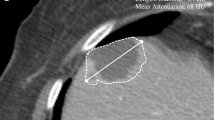Abstract
Objective
Anti-angiogenic drugs cause a reduction in tumour density (Choi criteria) first and then in size [Response Evaluation Criteria In Solid Tumours (RECIST)]. The prognostic significance of changes in tumour density in metastatic renal cell carcinoma (mRCC) is unknown and was assessed in this study.
Methods
The prognostic significance of partial response (PR) as opposed to non-response [stable disease (SD) + progressive (PD)] to anti-angiogenic therapy was assessed in patients with mRCC separately for both criteria using the log-rank test and Cox regression models.
Results
Both criteria were applied to 35 patients. The response was identical for all eight patients with PR and most patients with PD (10/12) when using the RECIST and Choi criteria. Adding tumour density information, 14 patients with SD were re-categorised as having PR (7), SD (4), and PD (3). Patients with PR (Choi) were progression free significantly longer [hazard ratio (HR) 0.24; 95 % CI 0.10–0.57; P = 0.001] and had better overall survival (HR 0.36; 95 % CI 0.15–0.89; P = 0.026) compared to patients with SD or PD. The predictive value of PR according to RECIST was not statistically significant.
Conclusions
In mRCC, the Choi criteria separate prognostic groups better when compared with RECIST. This may allow early discrimination of patients benefiting from continued treatment.
Key Points
• CT is widely used to assess patients with metastatic renal cell carcinoma.
• Various algorithms can be applied for tumour therapy control in patients with mRCC.
• Follow-up should be based on evaluation of the tumour size and density.
• RECIST is based only on tumour shrinkage and might lead to wrong conclusions.





Similar content being viewed by others
References
Eisenhauer EA, Therasse P, Bogaerts J et al (2009) New response evaluation criteria in solid tumours: revised RECIST guideline (version 1.1). Eur J Cancer 45:228–247
Choi H, Charnsangavej C, Faria SC et al (2007) Correlation of computed tomography and positron emission tomography in patients with metastatic gastrointestinal stromal tumor treated at a single institution with imatinib mesylate: proposal of new computed tomography response criteria. J Clin Oncol 25:1753–1759
Siegel R, Naishadham D, Jemal A (2012) Cancer statistics. CA Cancer J Clin 62:10–29
Chow WH, Devesa SS, Warren JL, Fraumeni JF Jr (1999) Rising incidence of renal cell cancer in the United States. JAMA 281:1628–1631
Escudier B, Eisen T, Stadler WM et al (2007) Sorafenib in advanced clear-cell renal-cell carcinoma. N Engl J Med 356:125–134
Motzer RJ, Hutson TE, Tomczak P et al (2007) Sunitinib versus interferon alfa in metastatic renal-cell carcinoma. N Engl J Med 356:115–124
Motzer RJ, Escudier B, Oudard S et al (2008) Efficacy of everolimus in advanced renal cell carcinoma: a double-blind, randomised, placebo-controlled phase III trial. Lancet 372:449–456
Hudes G, Carducci M, Tomczak P et al (2007) Temsirolimus, interferon alfa, or both for advanced renal-cell carcinoma. N Engl J Med 356:2271–2281
de Reijke TM, Bellmunt J, van Poppel H, Marreaud S, Aapro M (2009) EORTC-GU group expert opinion on metastatic renal cell cancer. Eur J Cancer 45:765–773
Development Core Team R (2011) R: A Language and environment for statistical computing. R Foundation for Statistical Computing, Vienna
Smith AD, Lieber ML, Shah SN (2010) Assessing tumor response and detecting recurrence in metastatic renal cell carcinoma on targeted therapy: importance of size and attenuation on contrast-enhanced CT. AJR Am J Roentgenol 194:157–165
Smith AD, Shah SN, Rini BI, Lieber ML, Remer EM (2010) Morphology, Attenuation, Size, and Structure (MASS) criteria: assessing response and predicting clinical outcome in metastatic renal cell carcinoma on antiangiogenic targeted therapy. AJR Am J Roentgenol 194:1470–1478
van der Veldt AAM, Meijerink MR, van den Eertwegh AJM, Haanen JB, Boven E (2010) Choi response criteria for early prediction of clinical outcome in patients with metastatic renal cell cancer treated with sunitinib. Br J Cancer 102:803–809
Miles KA (1999) Tumour angiogenesis and its relation to contrast enhancement on computed tomography: a review. Eur J Radiol 30:198–205
Miles KA, Charnsangavej C, Lee FT, Fishman EK, Horton K, Lee TY (2000) Application of CT in the investigation of angiogenesis in oncology. Acad Radiol 7:840–850
Acknowledgements
The authors (SP and GB) thank Bayer Healthcare, Switzerland, for general support by an unrestricted research grant.
Author information
Authors and Affiliations
Corresponding author
Rights and permissions
About this article
Cite this article
Schmidt, N., Hess, V., Zumbrunn, T. et al. Choi response criteria for prediction of survival in patients with metastatic renal cell carcinoma treated with anti-angiogenic therapies. Eur Radiol 23, 632–639 (2013). https://doi.org/10.1007/s00330-012-2640-x
Received:
Revised:
Accepted:
Published:
Issue Date:
DOI: https://doi.org/10.1007/s00330-012-2640-x




